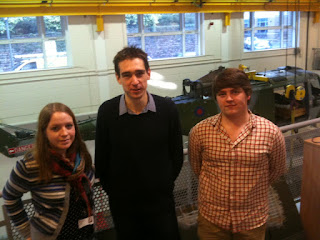 |
| Left-to-right: Gillian Clare, Ollie Turnbull and Tom Kent |
Gillian Clare rejoins us to work as a postdoctoral researcher on the "ONBOARD" project. ONBOARD is a research project within the WP-E Long Term and Innovative Research Work Package of SESAR, the Single European Sky ATM Research joint undertaking. Led by Spanish technology group GMV and in collaboration with Swiss ATM developers Skysoft, ONBOARD stands for "Probabilistic Network Based Operations ATM R&D". The goal of the project is to improve large scale operations planning by incorporating probabilistic models of the uncertainty in the system. Gillian's role will be to develop the "Network Manager" that solves the ATM flow problem robustly, to suit the uncertainty information available. The work will also involve research into the development of the probability models themselves, to cover capacity factors including weather and scheduled demand. Read more about the ONBOARD project at its page on the ComplexWorld ATM research network. Gillian herself is familiar to this blog, having done her PhD with us, studying optimization of airport taxi operations, and rejoins us after a spell in industry.
Like Gillian, Ollie Turnbull also did a PhD here, using decision trees to clone the behaviour of trajectory optimizers, before moving to industry. Ollie rejoins us now as the postdoctoral researcher on our second SESAR WP-E project, SUPEROPT. This project is led by and completely performed by ourselves at Bristol. SUPEROPT stands for "Supervision of Route Optimizers" and seeks to enable more intuitive human interactions with optimizers. As many frustrated Sat-Nav users will know, route optimizers are often worryingly good at finding the loopholes in the problems we set them, especially when we try and modify the routes using our own experience. SUPEROPT aims to develop forms of constraints that enable the supervisor to easily influence the outcome, but without overconstraining the result. Likewise, enhanced information on the result will be developed to convey the rationale to the supervisor: why is the result the way it is? With this two-way interaction, we hope to leverage the power of computer optimization without losing the hard-earned experience of human operators. Read more about SUPEROPT on the HALA! ATM research network page.
Finally, Tom Kent joins us to study for a PhD in future air traffic operations. Supported by Airbus UK at Filton and EPSRC, Tom is exploring the mathematics underlying novel concepts for aircraft operations with reduced environmental impact and cost, starting with formation flight. This idea is described in this Future by Airbus video and was demonstrated on a small scale by NASA. It worked for two F/A-18s following the same route, but what about airliners on different routes? Tom's work looks at when and where airliners should meet, if at all, to save fuel by flying in formation. Tom joined us after completing a Maths degree at Edinburgh. His background serves him well, as these problems are turning out to involve some very elegant geometry: watch this space to see how it all relates to Fermat...